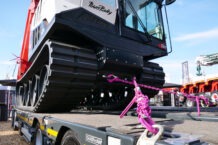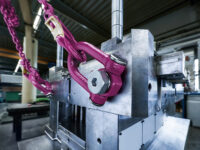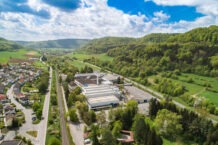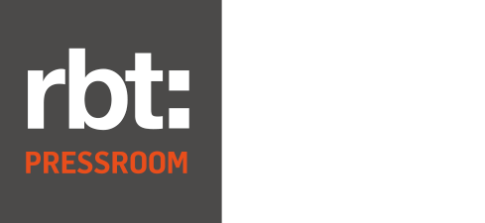“We wanted to show a textbook example of lashing that meets all the technical standards and thus also all the legal requirements”: anyone wanting to know why a Kässbohrer PowerBully 12D was presented at bauma 2025 secured to a Goldhofer TRAILSTAR low loader with RUD lashing equipment can find the answer in this statement by Felix Maier. The RUD key account manager was the driving force behind the trade fair project that united the vehicle manufacturers Goldhofer AG and Kässbohrer Geländefahrzeug AG, the lifting and lashing equipment specialist RUD Ketten Rieger & Dietz GmbH u. Co. KG and the construction and logistics company Max Wild GmbH. “South German Alliance” is the name that the quartet has given to this partnership, the aim of which is to stand up for more consistent load securing when earth-moving machinery is transported by road and to work together to set a good example – in the full knowledge that it is not only up to the users. On the contrary: “We believe that the responsibility clearly lies with the vehicle manufacturer. They must think about the loading concept during the development stage,” says Roman Ströbele of Kässbohrer Geländefahrzeug. The project partners are focusing on lashing points. They are standard in every earth-moving machine and every transporting vehicle and should therefore be an integral part of every responsible vehicle design right from the start. This is a key message of the “South German Alliance”. Felix Maier from RUD summarises the shared conviction of the four alliance partners as follows: “correct load securing begins in the development stage.”
Suitable lashing points indispensable according to the legal situation
This message is not new. For a long time now, experts have been urging manufacturers to pay more attention to load securing during the development of construction machinery and heavy goods vehicles and to place greater emphasis on lashing points. Strictly speaking, the legal situation leaves no other option here. Section 22 of the German Road Traffic Ordinance (StVO) expressly requires loads to be secured during transport in such a way “that they cannot slip, fall over, roll back and forth, fall off or cause avoidable noise even in the event of an emergency stop or sudden swerving.” According to the StVO, “the recognised codes of practice” must be observed here. For the transportation of earth-moving machinery by road, these can be found in the technical guideline VDI 2700 and in the European standard DIN EN 12195-1 – much-quoted sets of rules that, among other things, make the importance of the subject of lashing points clear. For example, VDI 2700 expressly stipulates that both the earth-moving machinery that is to be transported and the transporting vehicle must have suitable lashing points, while DIN EN 12195-1 standardises the calculation of the necessary securing forces in this respect. For the lashing points themselves, the relevant codes of practice are defined in the international standard ISO 15818:2017 and in the European standard DIN EN 12640:2020-05. These regulations specify, for example, how the lashing points have to be positioned and labelled and formulate requirements for materials, the minimum lashing capacity and quality control. Thus, there is a normative framework that leaves little scope for neglecting the subject of lashing points, especially as these standards are also consulted as a reference for the legal assessment of the load securing during inspections or accident reconstructions.
Development practice characterised by negligence
However, even when the legal situation is actually clear and the pleas of the “South German Alliance” and all the other experts are ultimately only expressing a self-evident fact, theory and practice – as is so often the case – do not coincide here. In the development of earth-moving machinery and heavy goods vehicles, the normative framework of StVO and the technical guidelines is undermined with an almost traditional regularity, and the manufacturers often only learn from repeated mistakes. These mistakes include, for example, calculating the lashing points for newly developed vehicles in compliance with the standards, but not updating the calculations for the next generation of vehicles and not adapting them to changes in the conditions. “In some vehicles, manufacturers are still installing lashing points whose basic parameters were determined 20 years ago,” reports Maier, who has already examined many lashing point solutions in the vehicle sector. In such cases, the fact that the machines have become bigger, wider and heavier in the meantime – even dramatically heavier in some cases because of electric batteries – is disregarded and is often only called to mind by critical examination or even by lashing-related accidents.
Another mistake that manufacturers make in the handling of lashing points, often with serious consequences, is to frequently pay too little attention to quality. Instead of investing in high-quality and certified lashing point solutions with a clearly defined securing performance, many manufacturers are content with comparatively simple self-made padeyes or burnout holes without labelling, manufacturer’s information or a defined lashing capacity – i.e. substandard solutions that often show considerable deformation after the first serious load and have sharp edges which can damage the lashing straps and chains as well. The fact that such lashing points do not meet the normative requirements and would actually need to be rectified by the user is by no means concealed. On the contrary, it is evident from the vehicle user manuals, which also document the lashing points. However, the deficiencies are often only clear to experts, while users blindly trust in the manufacturer and the solution in their day-to-day work. If damage occurs in spite of correct lashing because the lashing points do not hold up, the user cannot wash their hands of it, citing failings on the part of the manufacturer: “The carrier, the shipper and the driver always share the liability,” says Felix Maier about the legal situation. This means that the person who has put their trust in the lashing point becomes legally liable for its weakness.
Relieving the burden on the manufacturers through a partnership with lashing equipment specialists
The members of the “South German Alliance” emphatically criticise the fact that users are ultimately left to fend for themselves. Providing a counterpoint to this is a key motivation for the companies involved when it comes to their collective endeavour. “As a manufacturer of heavy goods vehicles, we have primary responsibility for ensuring that a load can be safely transported from A to B,” says Florian Bischofberger, PR & Marketing Manager at Goldhofer, who has little sympathy for negligence when it comes to safety. Nevertheless, lashing equipment expert Maier comes to the defence of the criticised manufacturers to some extent: according to his observations, the deficiencies in the area of lashing points are also due to the fact that load securing concepts and lashing equipment calculations are not part of the core skills of the development engineers. He says that they take the standards seriously and employ complex calculations, but are too unfamiliar with the subject matter as a whole and are also too preoccupied with other design questions. “Freeing them from the task of having to resolve issues that are outside their area of expertise but are associated with a high safety responsibility, in addition to their core activities, is one of the key services that we offer as a lashing equipment specialist,” says Maier, emphatically promoting a partnership with a specialist such as RUD.
Exemplary implementation of a lashing point solution
The Kässbohrer PowerBully 12D and the Goldhofer TRAILSTAR low loader exploited the potential of such a partnership for relieving the burden on the manufacturers in exemplary fashion. Both vehicle manufacturers sought to collaborate with the RUD lashing equipment experts right from the development stage and fitted out their special-purpose vehicles with high-quality RUD lashing points. The PowerBully 12D was furnished with LPW (lashing-point-welding) weldable lashing points with a lift bail that has a pivoting radius of 180° and can be loaded up to 90° in the load ring plane. The TRAILSTAR low loader has Optilash-Fix lashing points with a guiding retainer integrated into the loading platform; they can be loaded on all sides, have a high corrosion resistance and are easy to pull out and occupy as required – including to achieve flat lashing angles. In both vehicles, the lashing point solution was carefully calculated in the development phase, taking all the worst case scenarios into consideration, and adjusted to all the relevant vehicle parameters. The rounded design of both lashing points prevents damage to the lashing straps or chains, the high-quality steel provides a much higher material quality than all self-made padeyes, and a detailed and precisely documented quality control is a matter of course in any case. Both types of lashing point also feature a clear indication of the permissible lashing capacity and an individual manufacturer’s code, which makes seamless tracking possible.
Solution also convincing from the user’s perspective
By achieving lashing solutions that exactly meet all the normative requirements and thus create the conditions for optimal load securing in an exemplary manner, the partnership has also won over the construction and logistics company Max Wild. As the fourth partner in the quartet of the “South German Alliance”, it represents the users, who are always reliant on their chain excavators, wheel loaders or road rollers being transported safely to the job site and thus benefit most from advances in the area of load securing. Managing Director Roland Wild and his employees deliberately use the PowerBully 12D in conjunction with the TRAILSTAR low loader in their building projects and thus benefit not only from the advantages of the Goldhofer and Kässbohrer Geländefahrzeug construction and transporting vehicles, but also from the extremely reliable transport securing that is achieved by the high-quality RUD lashing points. On this basis, it was an obvious step for Max Wild to join the “South German Alliance” as an alliance for correct load securing and to strive for exemplary load securing when construction machinery is transported by heavy goods vehicle on the side of the users. “The fact that a user is clearly committed to a solution package that fully meets with all the standards and legal requirements relating to lashing points sends out a very important message,” says Felix Maier, who also explicitly welcomes this step.
The RUD lashing equipment expert only has words of praise for the determination to find a solution that is demonstrated by RUD’s project partners at Goldhofer and Kässbohrer Geländefahrzeug. “We have to take our hats off to them because they address the issue of load securing correctly right from the start,” says Maier. The partners themselves are full of positive feedback. “RUD is more than just a lashing point” is the refrain from the development departments, and Roman Ströbele of Kässbohrer Geländefahrzeug and Florian Bischofberger of Goldhofer make it clear why: “from advice and support with the practical application to the follow-up service, the collaboration with RUD was always outstanding,” agree the two vehicle specialists. However, the most important thing for the four project partners of the “South German Alliance” is ultimately their shared commitment to greater consistency and quality awareness in the area of load securing and lashing points in particular. “If our example sets a precedent and is followed by others,” says Maier, “we have already achieved a lot. Because the users of earth-moving machinery and heavy goods vehicles can and should expect the manufacturers to provide them with equipment on which they can rely – even when they have to transport it from A to B.”











